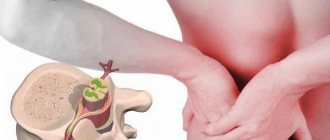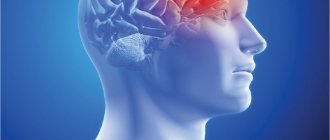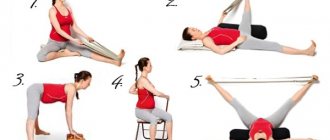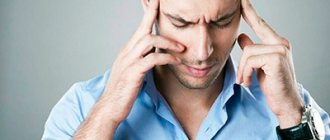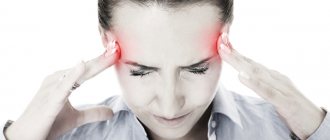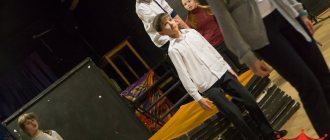Osteochondrosis is a chronic degenerative dystrophic disease in which gradual destruction of the cartilage tissue of the intervertebral discs occurs. They lose their elasticity and shock-absorbing ability, and stop protecting the radicular nerves extending from the spinal cord from compression. A decrease in the height of the intervertebral discs leads to instability of the position of the vertebral bodies, their constant displacement, which can cause the development of spinal canal stenosis.
Strain syndrome is excessive tension of the muscle fibers in the area of the affected area of the spinal column. In this way, the body tries to compensate for the decrease in the height of the intervertebral disc and eliminate compression from the radicular nerve. These signs are important in the differential diagnosis of osteochondrosis with other possible pathologies.
Tension syndrome in osteochondrosis helps the neurologist to clarify the degree of damage to the cartilage tissue of the disc and compression of the radicular nerve. There are several symptoms of tension: Lasegue, Neri, Matskevich, Vaserman, Sekar, Bekhterev and Dejerine. We will examine some of them in detail in the proposed material.
If you find at least one of them in yourself, then do not hesitate to contact a neurologist. Such a manifestation indicates that there is serious damage to the nerve fiber. Without timely treatment, this condition can provoke atrophy of the radicular nerve and trigger a cascade process of innervation disruption. In this case, not only the muscles of the back frame can be damaged, but also the lower limbs, vascular bed, and internal organs of the abdominal cavity and pelvis.
If you have symptoms of tension, then in Moscow you can make an appointment with a neurologist at our manual therapy clinic. The initial appointment is free for each patient. During the consultation, an experienced doctor will check whether you really have a positive symptom of tension due to osteochondrosis. Once an accurate diagnosis is made, an individual treatment plan will be developed.
Positive symptoms of tension in neurology
Let's look at some symptoms of tension in neurology. The most common symptom of root tension is Lasegue's syndrome. It indicates an ongoing muscle spasm that accompanies vertebrogenic pain syndrome. The nerve roots are blocked by spasmed muscles. When making sudden movements of the leg or body with a positive Lasegue tension symptom, a nerve fiber may rupture. Therefore, the patient is shown bed rest and complete physical rest until the muscle spasm passes.
Bilateral symptoms of tension in neurology with osteochondrosis appear when large nerves responsible for the innervation of the lower extremities are damaged. For example, bilateral Lassègue's syndrome may be present with sciatica (inflammation of the sciatic nerve). The same sign may indicate piriformis syndrome, plexopathy of the lumbosacral and coccygeal nerve plexuses.
With positive Lasegue syndrome in osteochondrosis, the following clinical signs are present:
- when trying to raise the upper leg on the side of the lesion of the radicular nerves, the patient experiences a severe exacerbation of the pain syndrome;
- when the position of the body in space changes, a sensation of pulsation occurs in the leg, associated with compression of a large nerve;
- there is no possibility to move the leg freely in the lateral direction.
When determining Lasègue tension syndrome, the physician must determine at what angle the patient can lift the leg upward. The condition of the limb in a flexed state is also assessed. If the pain when bending the knee joint decreases, this indicates that the symptom is positive.
Symptoms of tension in lumbar osteochondrosis
Let's consider other symptoms of tension in lumbar osteochondrosis, one of which is called planting syndrome. It indicates the etiology of pain in the spinal column. It can also be used to assess the condition of the radicular nerves. In order to evaluate the symptoms of tension in osteochondrosis of the lumbar region, it is necessary:
- ask the patient to take off his shoes and sit on the couch so that his back is tilted back and his legs remain straight and parallel to the floor;
- the patient should remain in this reclining state for approximately 20–30 seconds;
- the appearance of complaints of acute pain in the knee joint and falling on the back due to exceeding the pain threshold in the lumbar spine indicates that the landing syndrome is positive.
While the patient is in a reclining position on the couch, it is important to conduct a palpation examination of the area in which pain is detected. Reflex tension in certain areas of the muscular frame of the back and lower back indicates that destruction of individual intervertebral discs has occurred.
In the event that the patient can remain in a reclining position with straightened legs for a long time, the diagnosis of lumboischialgia is not confirmed. You should look for the cause of pain in other parts of the musculoskeletal system. Most often this is deforming osteoarthritis of the iliosacral joints or spondyloarthrosis of the coccygeal-sacral joint. With these pathologies, tension syndromes remain negative.
Tripod symptom for osteochondrosis
Another reliable sign of the development of osteochondrosis is tripod syndrome. It allows you to distinguish between psychogenic pain in the back and that reflected in the development of pathologies of the internal organs of the chest and abdominal cavity. Using the tripod syndrome, the doctor can assess the condition of the spinal column, the muscular frame of the back, nerve fiber, tendon and ligament apparatus.
With vertebrogenic pain syndrome, characteristic clinical signs are present. This is muscle tension and spasm, the inability to perform certain actions, a feeling of stiffness and much more.
A specific sign of the development of osteochondrosis and an attack of vertebrogenic radicular pain is tripod syndrome. In order to recognize this tension syndrome, the doctor must pay attention to the position of the patient’s body when trying to rise from a lying position, when sitting on a chair, when getting out of bed, etc.
Distinctive signs of positive tripod tension syndrome:
- lying on his back, the patient tries to raise his torso by resting his hands on a hard surface; if he sits down in a semi-recumbent position, he must support the weight of his torso by resting on his hands;
- when asked to get out of bed, the patient first turns over on his side or stomach and only after that, leaning on his hands, he rises, while trying not to use the muscles of the back and lower back as much as possible;
- the seating position on the chair is also specific - the torso is tilted back, the arms are moved behind the back and the body weight is transferred to them.
Tripod syndrome is a unifying term for all positions of the human body in which he tries to maximally unload the muscles of the back and lower back and at the same time transfer weight to his arms.
III. Examination for radiculopathies
It is carried out both to clarify the diagnosis and to exclude diseases that are potentially life-threatening for the patient (for example, tumors, metastases, spinal fractures and others) and to select the optimal treatment tactics.
Most often prescribed:
- radiography (spondylography) with functional tests,
- electroneuromyography
- computed tomography (CT)
- magnetic resonance imaging (MRI),
- Ultrasound diagnostics
- osteoscintigraphy,
- Dopplerography of blood vessels (for symptoms of the cervical spine),
- densitometry
- additional types of examination (blood tests, serological tests, abdominal organs, radiography of the skull, pelvic bones, etc.)
Symptoms of tension in cervical osteochondrosis
Osteochondrosis of the cervical spine also gives symptoms of tension, which manifest themselves in the collar area, upper chest, and shoulders. Determining the symptoms of tension in cervical osteochondrosis is quite simple - for this, the person needs to be asked to raise or move their arm to the side, and tilt their head.
For example, with positive Bonnet tension syndrome, the patient cannot move the arm raised to shoulder level to the side and bring it back. In this case, the upper limb on the side where there is no damage to the radicular nerve moves freely in different directions. In Bonnet syndrome, sensory disturbances are also present. Local areas of decreased skin sensitivity are identified along the back surface of the shoulder and forearm. When palpating the cervical spine, shoulder, collar area and upper limb, pain is detected only at the site of localization of degenerative dystrophic destruction of the intervertebral disc.
The Wasserman-Matskevich symptom is a combination of two clinical signs that appear with severe muscle tension in the neck and collar area. To determine them, the patient is asked to lie on his back on a hard surface. Then he should take turns raising his arms up in front of him and abducting them in different directions at different angles. With positive tension syndrome, raising your arm up in front of you will be accompanied by severe pain in the area of the shoulder blade and forearm.
Neri's tension syndrome may indicate inflammation or compression of the dorsal roots of the spinal cord. To determine it, the patient must stand up straight with his legs straight. Then the doctor asks him to tilt his head as far as possible towards his chest so that his chin touches his chest. If it is impossible to do this on their own, the doctor helps the patient until the chin touches the sternum or until the patient says that he has severe pain in the lumbar or collar area. This tension syndrome is present with radiculitis, myelitis of the roots, herniated intervertebral disc in the cervical spine.
Neri's tension syndrome can be positive when osteophytes grow in the area of the cervical and cervicothoracic spine, osteochondrosis with radicular syndrome, displacement of vertebral bodies, destruction of intervertebral joints with compression of the roots, etc.
Also, with cervical osteochondrosis, Dejerine's syndrome is of great diagnostic importance. It indicates damage to the membranes of the spinal cord. If a person experiences pain only during a certain type of physical activity, for example, when turning the head to the side, then this indicates a positive symptom of Dejerine’s tension.
II. Main clinical manifestations of radiculopathy
Pain syndrome:
- It may be local in nature, but pain along the nerve is more typical (irradiation is possible up to the tips of the fingers of the limbs).
- The pain can have different sensations: aching, piercing, burning, etc.
- Sometimes the pain is acute and appears suddenly (for example, shooting in the lumbar region - lumbago), but often it is chronic in nature, aggravated by physical activity, awkward movements, heavy lifting, or prolonged stay in a forced position.
- The intensity of pain can vary: from mild to severe, requiring immediate pain relief; sometimes patients freeze in a forced position.
- The pain may worsen with movement, sneezing, coughing, etc.
Impaired sensitivity and muscle strength (usually correspond to the areas of innervation of the affected root)
- They are manifested by paresthesia: a feeling of numbness, a feeling of “crawling goosebumps”, etc.
- It is also possible to disrupt other types of sensitivity: temperature, pain.
- With a long course of the disease, atrophy (decrease in volume) of the muscles of the diseased limb and weakness in it, up to paralysis, may occur.
Static violations
They are more characteristic of the cervical and lumbar spine and can manifest themselves in the form of:
- smoothness or complete absence of lordosis and the appearance of scoliosis with rotation of the vertebral bodies around the vertical axis, which at the onset of the disease can be of a temporary transient (functional) nature;
- restrictions on the mobility of the spine with the adoption of forced (antalgic) postures that help reduce pain;
- displacement of the vertebral bodies relative to each other (spondylolisthesis).
Symptoms of tension
They are manifested by the occurrence or intensification of pain when straightening or raising a limb. These pains are mainly associated with irritation of the root during movements, as well as with an increase in cerebrospinal fluid pressure (Dejerine's symptom, or cough impulse) and are mainly discogenic in nature. For example, with lumbosacral radiculitis - raising straightened legs (from a horizontal position of the patient’s body - Lassegue’s symptom), when bending the body forward with straightened legs, when bending the head, when coughing, etc.
Autonomic disorders
They are most often associated with the involvement of sympathetic fibers in the process and are manifested by a violation of vascular reactions, thermoregulation, etc., this sometimes misleads the patient, as it can simulate signs of another disease, especially with cervical and thoracic osteochondrosis.
At the initial stage of the disease, patients are recommended to:
- restriction of movements in the cervical or lumbar spine (immobilization with wearing an orthopedic collar or belt);
- warmth and rest (up to bed rest) in the first 2-3 days of the onset of the disease;
- taking painkillers;
- consultation with a neurologist (vertebroneurologist).
What to do if tension pain syndromes appear
Painful tension syndromes indicate that compression damage to the structures of the autonomic nervous system occurs. This may be the spinal cord, its dural membranes or radicular nerves. In any case, muscle spasm occurs, which is not relieved by the use of non-steroidal anti-inflammatory drugs. Pain from muscle tension can only be relieved with the help of muscle relaxants. But this measure does not always give a positive result.
What to do if tension pain syndromes appear? It is necessary to conduct a thorough differential diagnosis. This should be done by a neurologist, vertebrologist or orthopedist. These doctors determine what pathological change has occurred in the tissues of the spinal column. Then, after an accurate diagnosis is made, treatment is carried out.
It is most effective to treat osteochondrosis and its complications using manual therapy methods. The following techniques are used:
- osteopathy allows you to restore normal processes of microcirculation of blood and lymphatic fluid, due to which the physiological structure of the tissue is restored;
- massage improves the elasticity and permeability of muscle tissue, increases its saturation with oxygen and glucose, which has a positive effect on the diffuse nutrition of cartilaginous intervertebral discs;
- therapeutic exercises and kinesiotherapy regulate the tone of the muscular frame of the back and restore its performance;
- reflexology allows you to start the process of regeneration of all damaged tissues by using the hidden reserves of the human body.
Physiotherapy, laser treatment and much more are also used. If you need effective and safe treatment for tension pain syndromes due to osteochondrosis of the spinal column, then you can contact our manual therapy clinic in Moscow. Here you will be offered a free initial examination. During it, a preliminary diagnosis will be made and recommendations for subsequent examination and treatment will be given.
Amyotrophic lateral sclerosis - symptoms and treatment
Amyotrophic lateral sclerosis ( ALS ) is a steadily progressive disease characterized by the death (degeneration) of motor neurons, which leads to impaired muscle movement, including respiratory muscles, up to paralysis and muscle wasting.
To understand the essence of the disease, it is necessary to touch upon the structure and functions of the brain and spinal cord. In the structure of the spinal cord along its entire length and partially in the brain stem, there are cells that send nerve impulses directly to the muscle fibers. They are called lower motor neurons , since their impulses set the muscles in motion. Grouped in the anterior part of the transverse section of the spinal cord, the lower motor neurons form the so-called “anterior horn”.
The spinal cord also functions as a connecting nerve “cable” between the brain and parts of the body. Normally, the spinal cord is subordinate to the brain. This means that if an impulse from the brain tells the muscle to raise the arm, and an impulse from the spinal cord tells it to lower, the arm will rise.
The brain has a complex structure, but in this article we need to pay attention to upper motor neurons . They are grouped in the area that responds to the initial generation of motor impulses in the body - the cerebral cortex and the brain stem. The impulses, in turn, travel down the spinal cord to the aforementioned lower motor neurons, and from there to the muscles, causing them to move. It is this pathway that is affected in amyotrophic lateral sclerosis.
ALS was first described in 1869. In the literature you can find the following synonyms for ALS: motor neuron disease, motor neuron disease, Charcot's disease (named after the pioneering doctor, although this disease was discovered by Charles Bell [1]), Lou Gehrig's disease (named after the famous baseball player who died of ALS in 1938 ). Many people now call it Stephen Hawking's disease because he lived with ALS for over 50 years.
Amyotrophic lateral sclerosis is a representative of the group of motor neuron diseases, i.e. diseases of the motor neurons. In addition to ALS, this group includes: primary lateral sclerosis, progressive muscular atrophy and progressive bulbar palsy.
Scientists have identified two causes of ALS : 90-95% are a sporadic cause (in other words, an accident) and 5-10% are a genetically inherited mutation [2].
Over the course of many years of research, non-genetic modifiable lifestyle factors have been found that predispose to ALS :
- Cigarette smoking is the most consistent nongenetic risk factor for ALS [8].
- Contact with agricultural fertilizers: pesticides, herbicides, insecticides and formaldehyde [8]. It is worth mentioning that formaldehyde is found in tobacco smoke in everyday life, so passive smoking should also be avoided.
- Lead released into the environment during professional activities, for example, when welding metals [10].
- Microtraumas of the head in professional sports [9]. This means that Lou Gehring, being a baseball player, probably caused ALS and early death 2 years later through his profession.
To summarize the above, ALS develops as a result of the combined influence of genes, environmental factors and lifestyle factors. This gene-time-environment model suggests that the development of ALS is a multistep process in which genetic defects are only one of several steps that ultimately lead to ALS.
There are approximately 10-12 thousand patients with ALS in our country. The disease is more common in men than in women (1.5 times), and the age range is from 20 to 80 years. The rate of its progression is directly proportional to age. The presence of a genetic mutation (in 5-10% of cases) also increases the rate of development of severe symptoms [14].
